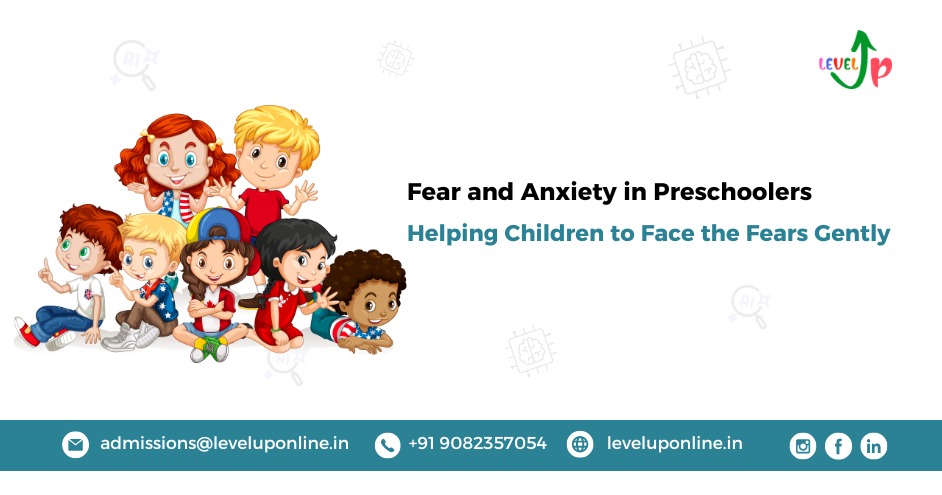Introduction
When it comes to fear and anxiety in preschoolers, the goal isn’t to eliminate fear altogether; it’s to build emotional tools so children can learn to face fears gently and with growing resilience. In ECCE (Early Childhood Care and Education), helping children navigate fear is not just a psychological necessity—it’s a foundational life skill. Whether it’s fear of the dark, strangers, or loud noises, these reactions are developmentally appropriate. But what matters most is how caregivers and educators respond.
Understanding Fear in Early Childhood
Why Do Young Children Feel Afraid?
Fear is nature’s defense system. For toddlers and preschoolers, it’s also a sign that their world is expanding. They’re becoming aware of risks, differences, and uncertainty. Their growing imaginations—while wonderful—can also turn shadows into monsters.
Common Childhood Fears in ECCE Settings
1. Fear of separation from parents
2. Loud noises (like alarms or vacuum cleaners)
3. Fear of failure during activities
4. Stage fright during group time
5. Sensory overload in noisy or chaotic environments
Understanding these in the ECCE context helps teachers respond with empathy, not dismissal.
The Role of ECCE in Emotional Regulation
ECCE as a Safe Space for Expression
A quality ECCE environment encourages emotional expression. Here, children aren’t scolded for crying or hiding—they’re invited to talk, draw, or act it out through play.
Building Trust Through Gentle Guidance
Trust is everything. When educators respond to fear gently—kneeling to eye level, using a soft tone, or simply offering a hug—they validate the child’s emotional reality.
Psychological Roots of Fear in Early Years
Brain Development and Fear Responses
The amygdala—our brain’s fear center—is active from birth. But the prefrontal cortex, which regulates emotional responses, develops more slowly. That’s why fear and anxiety in preschoolers often requires adult help to soothe and understand.
Attachment and Emotional Safety
Children with secure attachments (to parents or educators) handle fear better. They know someone will protect them, making them more willing to take small emotional risks.
Strategies to Help Children Face Fears Gently
1. Normalize Fear Without Dismissing It
Instead of “There’s nothing to be scared of,” try:
“I can see that scared you. Want to hold my hand until you feel okay?”
This approach validates while also offering a pathway to safety.
2. Use Play-Based Techniques
Role-play, puppet shows, and emotional dolls are powerful in ECCE settings. A child afraid of dogs might ‘train’ a stuffed dog to overcome fear, projecting their inner struggle.
3. Slow Desensitization with Comfort Items
Introducing feared objects in a non-threatening way helps children reframe scary stimuli gently. This is a widely used method for reducing fear and anxiety in preschoolers.
4. Storytelling as Emotional Processing
Craft a story about a brave bunny who was scared of thunderstorms. Let the child draw what happens next. Stories let children step outside their fear, observe it, and rewrite it.
5. Breathwork and Calm-Down Corners
Simple breathing games—like blowing bubbles—teach self-regulation. Calm-down corners with soft lighting, textures, and quiet music can also anchor children during distress in ECCE settings.
Role of Educators and Parents in ECCE
Language Matters—Name the Emotion
Naming emotions gives children power over them. Saying, “You look nervous. Is something worrying you?” offers them a label and a lifeline.
Modelling Brave Behavior
If a teacher calmly holds a spider and talks about it gently, children notice. They mirror emotional tone more than instruction.
When Fears Become Anxiety: What ECCE Practitioners Should Watch For
1. Avoiding certain spaces consistently
2. Physical complaints like stomach aches with no medical cause
3. Trouble sleeping or eating at preschool
4. Intense clinginess beyond normal separation anxiety
In such cases, early intervention and family collaboration is key—another strength of a responsive ECCE program dealing with fear and anxiety in preschoolers.
The Importance of Environment in Soothing Fears
Creating Predictable Routines
Predictability reduces anxiety. A structured ECCE day gives children a sense of control, and fewer surprises means fewer fear triggers.
Designing Comforting Physical Spaces
1. Soft lighting
2. Warm colors
Safe, quiet corners
These elements create an emotional buffer zone in ECCE classrooms, especially helpful in managing fear and anxiety in preschoolers.
Celebrating Small Wins—The ECCE Way
Did a shy child volunteer to speak? Or a toddler finally touched a balloon they were scared of? Celebrate that. Gentle celebration encourages progress without pressure.
Final Thoughts: Gentle, Not Forceful
In ECCE, how we help children face fear shapes their lifelong emotional intelligence. Force teaches suppression. Gentleness teaches courage. And that makes all the difference.
Conclusion
Fear is not the enemy. It’s a messenger. In ECCE, we don’t rush children past their fears—we walk with them, gently, at their pace. Supporting fear and anxiety in preschoolers isn’t about erasing the emotion. It’s about guiding them through it, helping them name it, and slowly take away its power. And in doing so, we raise children who aren’t fearless, but brave. Because real bravery begins when we’re scared and still choose to grow.


